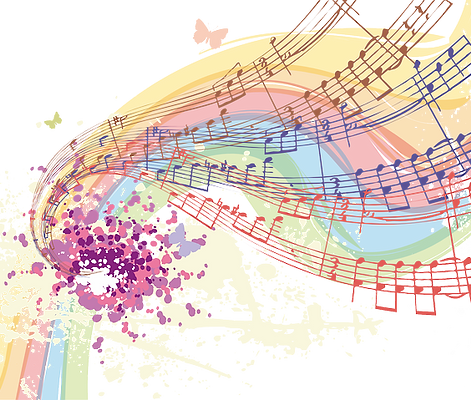Project by Sarah Martinez
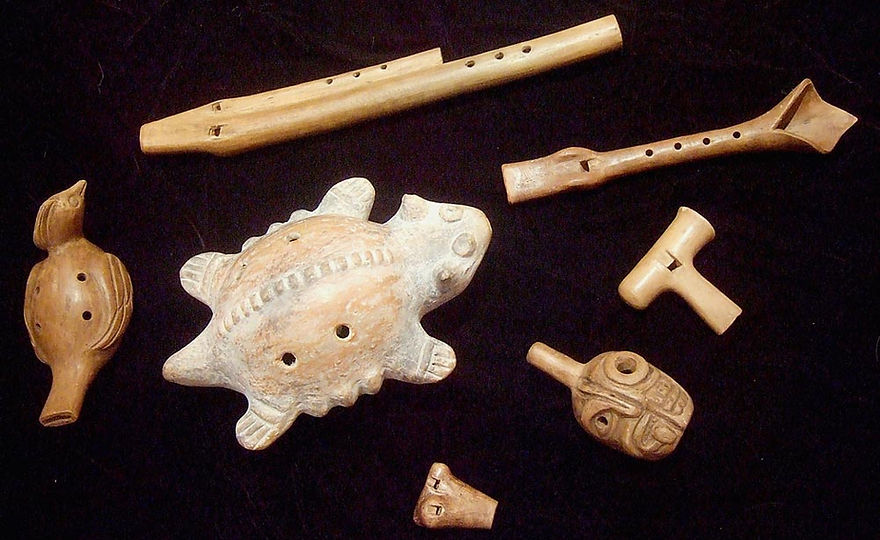
Flutes
Photo courtesy of www.mexicolore.co.uk
There are a multitude of flutes that are utilized in traditional Aztec music to create melodies and harmonies. The huilacapitztli (pictured above) is a carved wooden flute capable of creating various notes (Aztec Music 2006). Various trumpets and horns were also utilized in Aztec music. The tecciztli was a type of conch, while the quihquiztli was a type of snail horn that were frequently used during ceremonies and rituals (Aztec Music 2006). Not only can these instruments be used to create melodies in the music, but they are often also be used to mimic bird and wildlife calls, as well.
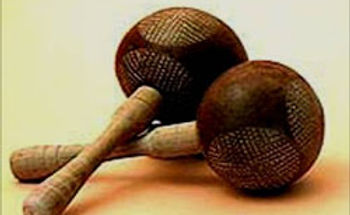
Rattles
Photo courtesy of www.allaroundthisworld.com
There are two main types of rattles used in traditional Aztec music. The first of these percussion instruments is the avacahtli (pictured above). This traditional instrument is constructed using two hollowed out gourds, which are then filled with beads (Aztec (Mexico) 2015). The second type of rattle utilized in Aztec music is the chicahuaztli. This instrument is a long rain stick which can be shaken to create various musical effects (Aztec (Mexico) 2015).
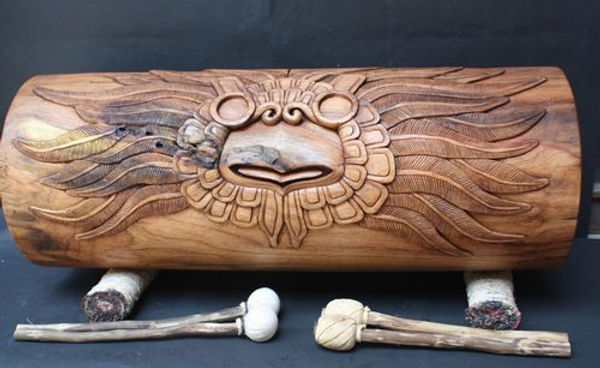
Drums
Photo courtesy of www.mexicanartdealing.com
There were various forms of drums used in Aztec music. The teponaztli (pictured above) was an intricately designed hollowed-out cylinder made of wood which was played with resin mallets (Aztec (Mexico) 2015). Due to the varying degrees of thickness of the wood, two tones could be derived from this instrument. Another popular drum of the time was the huehuetl. This drum is a large drum made of carved wood and animal skins, that stands waist high and produces a resounding deep tone (Aztec (Mexico) 2015). A tortoise shell drum, called an ayotl, was also a prominent feature in traditional Aztec music (Aztec (Mexico) 2015).
Interestingly, traditional Aztec music can be transcribed using contemporary time signature notations despite being written using a completely different format to represent varying beats (Aztec (Mexico) 2015). The vocalization of the syllables “To” “Ko” “Ti” and “Ki” were used to create percussion lines and various rhythms in the music (Aztec (Mexico) 2015).
Beliefs
Ancient Aztec religion involved an intricate interaction between deities, dates, commands, and standards. This polytheistic religion mainly revolved around a need to create balance in nature and a fear of the end of the world (Aztec Music 2006).
According to Aztec religion, it took the gods five tries to create the world, and after each unsuccessful attempt a natural disaster would destroy the world (Aztec Music 2006). In order to create balance in nature, each of the five gods sacrificed themselves to the sun so that the humans could survive (Aztec Music 2006).
Bloodletting and human sacrifices to honor the gods were common practices to keep nature in balance, as well as prevent natural disasters and famine (Aztec Music 2006).
Traditions
There are many Aztec traditions to choose from, below are a few of the most relatable to contemporary traditions.
Interestingly, the Aztecs had a ritual similar to contemporary trick-or-treating that they performed during the month devoted to the rain god. During this ritual people wore masks with grass hoops around their eyes (signifying the rain god Tlaloc) and walked from house to house demanding food and goods for the deity’s efforts in growing the crops (Aztec Music 2010). Home owners often complied under the threat of destruction to their homes.
Another interesting Aztec tradition resembles a contemporary pillow fight. On the day after a religious festival, commoners created small pillows using sacks and wool. The boys would then chase the girls around throwing these pillows, while the girls would defend themselves by chasing the boys away with small cactuses (Aztec Music 2010).
Culture
The Aztec culture is based on two main social classes, the pilli (nobility) and the macehualli (commoners). Vocations among the Aztec people were based on social class (Aztec Music 2006).
Slavery was utilized in the Aztec Empire. However, slaves were usually treated well and could earn their freedom fairly easily (Aztec Music 2006).
Education was a top priority among the Aztec people. Everyone was given an education regardless of gender or social class (Aztec Music 2006). As children grew older, gender specific responsibilities were taught thereby grooming them for adult life.
Marriages were generally polygamous arrangements that provided strategic social or economic advantages (Aztec Music 2006).
History
In general, the term Aztec is used to describe the culture whose inhabitants resided in what is considered present day Mexico. The Aztec culture thrived from the thirteenth through the sixteenth century and spoke mainly Nahautl (Aztec (Mexico) 2015).
The Aztec empire was based on a triple city-state alliance between Tenochtitlan, Texcoco, and Tlacopan (Aztec Music 2006). This trifecta grew in strength and power as they began to conquer surrounding city-states until the arrival of the Europeans in the early sixteenth century.
With the arrival of Cortes, the attack on the Aztec Empire began. Within a few short years, the Aztec Empire was completely destroyed through conquest and disease (Aztec (Mexico) 2015).
Uncovering an Ancient Civilization
A brief look at Aztec history and culture.
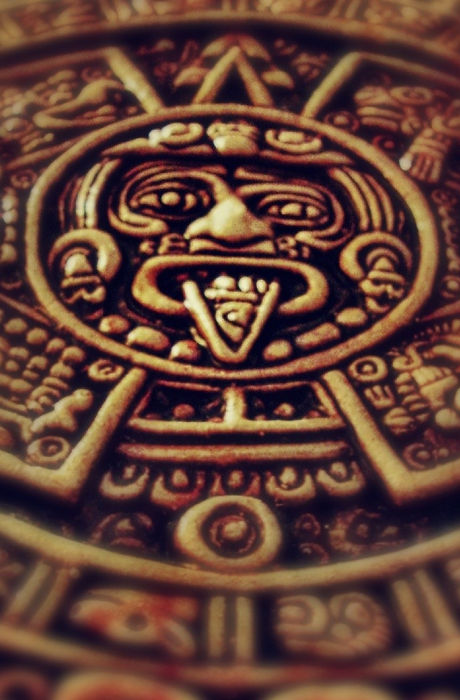
Works Cited
Photo courtesy of www.thinglink.com
Aztec (Mexico). All Around This World, 2015. http://www.allaroundthisworld.com/learn/latin-america/latin-america-genres-of-music/latin-america-aztec/#.WC5C0vkrJPZ. Accessed 10 November 2016.
Aztec Music. Aztec-History, 2006. http://www.aztec-history.com/aztec-music.html. Accessed 10 November 2016.
Aztec Music. Aztecs at Mexicolore, 2010. http://mexicolore.co.uk/aztecs/music. Accessed 10 November 2016.
Hansen, Bethanie, David Whitehouse, and Cathy Silverman. Music Appreciation. Charles Town: APUS E-Press, 2012.
Form
When identifying the form of a piece of music, one must consider how the piece unfolds and develops over time (Hansen, Whitehouse, and Silverman 10). Some Aztec music is primarily instrumental and is used in conjunction with elaborate dance rituals to pay homage to the gods. Other Aztec music utilizes traditional instruments to accompany poetic and symbolic lyrics to portray stories and emotions (Aztec Music 2010). The form of a piece of Aztec music is often dependent on the purpose that it serves.
Rhythm
Rhythm can be conceptualized by a strong, regular, and repeated sound found in music (Hansen. Whitehouse, and Silverman 9). Traditional Aztec music often possesses a rhythm that is strong, deep, and varied in tempo. Percussion instruments are often used to layer rhythms within a piece of music, as well (Aztec Music 2010). This layered and varied tempo aids in portraying emotion in the music.
Texture
While texture is the overall feel of a musical composition created by the layering of melody, harmony, and rhythm; monophony is in essence music that possesses one instrumental or vocal melody (Hansen, Whitehouse, and Silverman 10). Traditional Aztec music usually is comprised of a primary melody played by flutes and in rare cases a secondary melody which is interwoven with the use of conchs, vocals, and rattles. Aztec music possesses a particular mystical feel derived from the tribal beats and haunting flute melodies (Aztec Music 2010).
Timbre
Timbre, also known as tone color, often refers to the sound quality of a particular composition (Hansen, Whitehouse, and Silverman 8). The distinctly tribal music of the Aztec people can be described as having a complex, rich, and clear timbre.
Melody
A melody is defined as a distinguishable line of music comprised of various pitches (Hansen, Whitehouse, and Silverman 9). Melodies within Aztec music are often monophonic, higher pitched, and evocative.
Harmony
Essentially, harmony refers to the vertical relationship when two or more musical notes are sounded simultaneously (Hansen, Whitehouse, and Silverman 9). Aztec music is typically characterized as monophonic, interwoven with layered rhythms of percussion and what seems like sound effects of wildlife calls (Aztec Music 2010). Therefore, there is very little use of harmony within Aztec music.
Spirit World
During special rituals, participants would work themselves into a trance as they sang and danced for hours on end (Aztec Music 2006). While in this trance, participants would often reenact battles and human sacrifice rituals for spectators.
Cantares
Also known as “ghost songs”, these songs were meant to retell historical deeds and often served a mystical purpose (Aztec Music 2006). During battles, trained singers, dancers, and actors would perform these songs in order to bring good fortune to their people.
Hymns
Many songs were written to commemorate the deeds of the gods or simply to ask for the gods’ blessings (Aztec Music 2006). These songs were often sung during special occasions accompanied by sacred rituals and dances.
The Role of Music
Music was a continual and essential part of the Aztec culture. Aztec music served as a source of entertainment. It also served as a way to pass on cultural traditions, relay historical practices, share religious teachings, and connect emotionally to life events (Aztec Music 2006).

Exploring the World Through Music
The Aztec Empire
